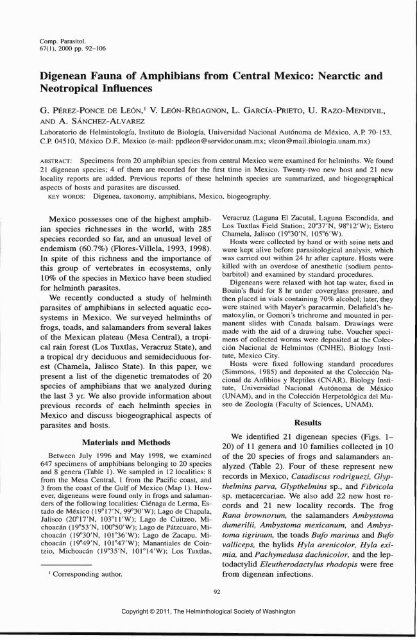Comparative Parasitology 67(1) 2000 - Peru State College
Comparative Parasitology 67(1) 2000 - Peru State College
Comparative Parasitology 67(1) 2000 - Peru State College
You also want an ePaper? Increase the reach of your titles
YUMPU automatically turns print PDFs into web optimized ePapers that Google loves.
Comp. Parasitol.<br />
<strong>67</strong>(1), <strong>2000</strong> pp. 92-106<br />
Digenean Fauna of Amphibians from Central Mexico: Nearctic and<br />
Neotropical Influences<br />
G. PEREZ-PONCE DE LEON,' V. LEON-REGAGNON, L. GARCIA-PRIETO, U. RAZO-MENDIVIL,<br />
AND A. SANCHEZ-ALVAREZ<br />
Laboratorio de Helmintologia, Institute de Biologia, Universidad Nacional Autonoma de Mexico, A.P. 70-153,<br />
C.P. 04510, Mexico D.F., Mexico (e-mail: ppdleon@servidor.unam.mx: vleon@mail.ibiologia.unam.mx)<br />
ABSTRACT: Specimens from 20 amphibian species from central Mexico were examined for helminths. We found<br />
21 digenean species; 4 of them are recorded for the first time in Mexico. Twenty-two new host and 21 new<br />
locality reports are added. Previous reports of these helminth species are summarized, and biogeographical<br />
aspects of hosts and parasites are discussed.<br />
KEY WORDS: Digenea, taxonomy, amphibians, Mexico, biogeography.<br />
Mexico possesses one of the highest amphibian<br />
species richnesses in the world, with 285<br />
species recorded so far, and an unusual level of<br />
endemism (60.7%) (Flores-Villela, 1993, 1998).<br />
In spite of this richness and the importance of<br />
this group of vertebrates in ecosystems, only<br />
10% of the species in Mexico have been studied<br />
for helminth parasites.<br />
We recently conducted a study of helminth<br />
parasites of amphibians in selected aquatic ecosystems<br />
in Mexico. We surveyed helminths of<br />
frogs, toads, and salamanders from several lakes<br />
of the Mexican plateau (Mesa Central), a tropical<br />
rain forest (Los Tuxtlas, Veracruz <strong>State</strong>), and<br />
a tropical dry deciduous and semideciduous forest<br />
(Chamela, Jalisco <strong>State</strong>). In this paper, we<br />
present a list of the digenetic trematodes of 20<br />
species of amphibians that we analyzed during<br />
the last 3 yr. We also provide information about<br />
previous records of each helminth species in<br />
Mexico and discuss biogeographical aspects of<br />
parasites and hosts.<br />
Materials and Methods<br />
Between July 1996 and May 1998, we examined<br />
647 specimens of amphibians belonging to 20 species<br />
and 8 genera (Table 1). We sampled in 12 localities: 8<br />
from the Mesa Central, 1 from the Pacific coast, and<br />
3 from the coast of the Gulf of Mexico (Map 1). However,<br />
digeneans were found only in frogs and salamanders<br />
of the following localities: Cienaga de Lerma, Estado<br />
de Mexico (19°17'N, 99°30'W); Lago de Chapala,<br />
Jalisco (20°17'N, 103°11'W); Lago de Cuitzeo, Michoacan<br />
(19°53'N, 100°50'W); Lago de Patzcuaro, Michoacan<br />
(19°30'N, 101°36'W); Lago de Zacapu, Michoacan<br />
(19°49'N, 101°47'W); Manantiales de Cointzio,<br />
Michoacan (19°35'N, 101°14'W); Los Tuxtlas,<br />
Corresponding author.<br />
Copyright © 2011, The Helminthological Society of Washington<br />
92<br />
Veracruz (Laguna El Zacatal, Laguna Escondida, and<br />
Los Tuxtlas Field Station; 20°37'N, 98°12'W); Estero<br />
Chamela, Jalisco (19°30'N, 105°6'W).<br />
Hosts were collected by hand or with seine nets and<br />
were kept alive before parasitological analysis, which<br />
was carried out within 24 hr after capture. Hosts were<br />
killed with an overdose of anesthetic (sodium pentobarbitol)<br />
and examined by standard procedures.<br />
Digeneans were relaxed with hot tap water, fixed in<br />
Bouin's fluid for 8 hr under coverglass pressure, and<br />
then placed in vials containing 70% alcohol; later, they<br />
were stained with Mayer's paracarmin, Delafield's hematoxylin,<br />
or Gomori's trichrome and mounted in permanent<br />
slides with Canada balsam. Drawings were<br />
made with the aid of a drawing tube. Voucher specimens<br />
of collected worms were deposited at the Coleccion<br />
Nacional de Helmintos (CNHE), Biology Institute,<br />
Mexico City.<br />
Hosts were fixed following standard procedures<br />
(Simmons, 1985) and deposited at the Coleccion Nacional<br />
de Anfibios y Reptiles (CNAR), Biology Institute,<br />
Universidad Nacional Autonoma de Mexico<br />
(UNAM), and in the Coleccion Herpetologica del Museo<br />
de Zoologfa (Faculty of Sciences, UNAM).<br />
Results<br />
We identified 21 digenean species (Figs. 1-<br />
20) of 11 genera and 10 families collected in 10<br />
of the 20 species of frogs and salamanders analyzed<br />
(Table 2). Four of these represent new<br />
records in Mexico, Catadiscus rodriguezi, Glypthelmins<br />
parva, Glypthelmins sp., and Fibricola<br />
sp. metacercariae. We also add 22 new host records<br />
and 21 new locality records. The frog<br />
Rana brownorurn, the salamanders Ambystoma<br />
dumerilii, Ambystoma mexicanum, and Ambystoma<br />
tigrinum, the toads Bufo marinus and Bufo<br />
valliceps, the hylids Hyla arenicolor, Hyla exirnia,<br />
and Pachymedusa dachnicolor, and the leptodactylid<br />
Eleutherodactylus rhodopis were free<br />
from digenean infections.
















